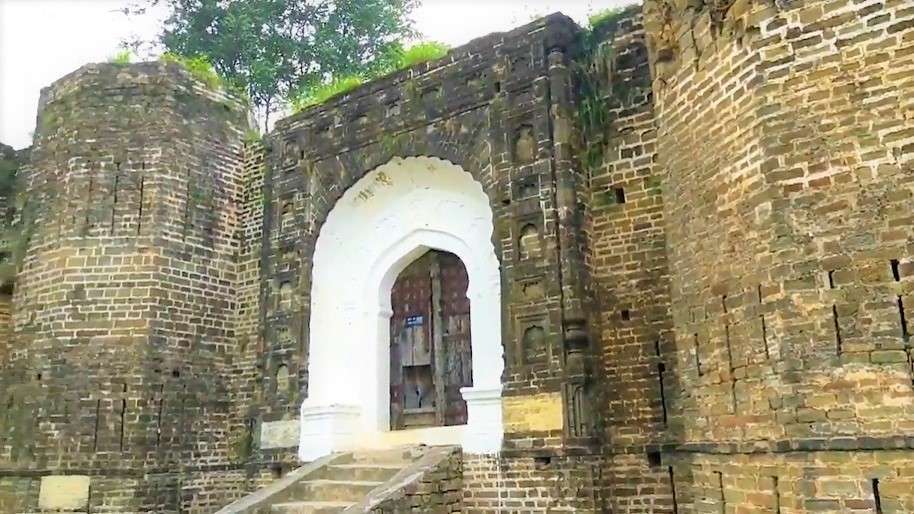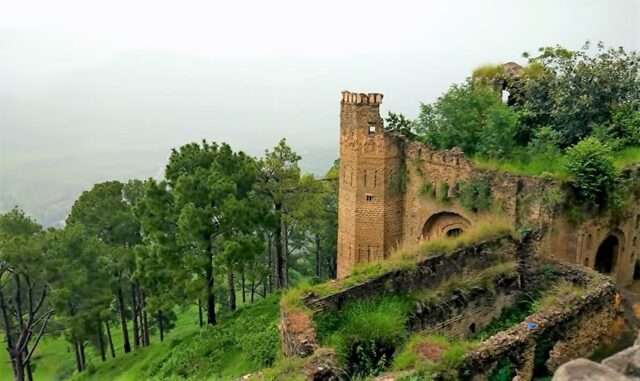Baghsar Fort – Land of Gardens and Water as it is a Persian word. It is situated in Samahni Valley near Bhimber. This stunning location is 12 kilometers east of Samahni Town and the same distance from Jandichontra.
It is 975 meters above sea level and makes for the perfect vacation destination in the Samahni Valley. Due to its gorgeous location and atmosphere, Baghsar is claimed to have been a focal point both during and after the Mughal Empire.
The Baghsar Fort is a historic fort situated in Pakistan’s Samahni Valley close to the town of Baghsar. The Mughal emperors built the fort. Due to its proximity to the border between Pakistan and India, some of it is currently off-limits to visitors.
A renowned fort with a view of the lake is perched atop the hill, adding majesty to the entire region. A granite structure with four stories, this engineering marvel has withstood the test of time. It also had a significant impact on history under the reigns of Gulab Sing, Ranjeet Sing, and Ahmad Shah Abdali.
History
About the real history of the fort, very little is known. Although it is popularly thought that the fort was constructed by the Mughals, Dhian Singh, the brother of Maharaja Ghulab Singh Dogra, according to Godfrey Vigne, an English traveler who travelled extensively in Kashmir, actually erected it. In his book, he referred to it as the Amur Gurh fortress.

Historians have varying views on who constructed this magnificent fort. Many think that the Moghul emperors were the ones who created this. Some claim that Baghsar Fort – Land of Gardens and Water was constructed by the Sikh kings following their victory over Raja Sultan Khan, the final monarch of the Bhimber kingdom, in 1812.
The exact history of this fort is only partially known due to the paucity of available data. GT Vigne claims that Deyhan Singh, Gulab Singh’s brother who succeeded his father as the Raja of Bhimber in 1826, constructed this fort. He claims this in his 1844 book, “Travel in Kashmir Ladakis and Iskardo.”
Some historians say that emperor Jehangir, who was travelling from Kashmir when he fell ill and passed away in this fort, had his internal organs removed and interred there to slow the decomposition process before his body was transported to Lahore for a final resting place. However, similar allegations are also made about Chingus Sarai, which is close to the town of Rajouri that is under Indian administration.
If we follow Jehangir’s relationship to this location, then we must go way beyond 1627 and deep into the Moghul era to find its origins. We are unable to paint a complete picture of this historical site due to insufficient information and some missing references, but despite conflicting theories about how it came to be, the architectural heritage of the Sub Continent is and will always serve as a constant reminder of our illustrious past in the building industry.
The Mughal emperor Jahangir passed away between Sarai Saadabad, Bhimber, and Chingus Sarai, Rajouri, while travelling from Kashmir to Lahore. His entrails were removed and interred at Baghsar fort in order to preserve his body. The body was then transported to Lahore, where it was interred in a mausoleum constructed by the banks of the Ravi.
Layout
The fort’s inner side is made up of the darbar hall, a pond, and forty-three smaller rooms, while the outer perimeter is made up of a boundary wall and thirty-eight smaller rooms. The fort has three entry points. The main entrance on the north side, the entrance on the east , and the entrance to the inner perimeter. On the southeast corner, there is a noticeable observation point. The western wall has a shooting bay. Wall embrasures all around the fort enable archers to fire while remaining concealed.
A small door leads to the entrance of the fort. This is not the main gate of the fort but it seems that this gate was made for servants. On this side, a large part of the wall was destroyed. It is said that sometime in the past, Indian artillery fired a shell here. After passing through here, on the north side is the main gate of the fort, which has a magnificent hallway inside.
The outer part of the Baghsar Fort – Land of Gardens and Water appears to be of the 17th century, while the arches of the hallway inside look much later. The decorative elements on the walls are clearly from Hindu culture and they indicate that the fort was also in the possession of the Dogra kings of Kashmir who repaired and destroyed it.
The arrangement of the Sadar door was such that no cavalry could enter it at high speed. And if he comes from a criminal contempt, he will find himself between the double walls of the fortress where arrows, spears and bullets are showered on him from both sides. One more feature of Saddar Durbari was that there were long iron spikes on it. Near the fort is a cistern that used to provide water to the keepers of the bygone era. Along the walls are living quarters for the soldiers.
There is a big room along the southern wall of Baghsar. Here the ruler of the time used to meet with his courtiers and delegations from all over the world. The remainder of the buildings above this room there was also a loft where the women sitting behind the curtains could see what was going on below.
Maintenance
Despite being under a zone of control, the fort’s structure is still standing. However, the government gives conservation little attention. For the fort to be repaired and the ancient masterpiece to survive, the Archaeological Department should make the necessary arrangements. Because the Baghsar Fort – Land of Gardens and Water is located so close to the line of control between Pakistan and India, it is currently off limits to visitors but some parts of Baghsar fort are currently open to tourists.











